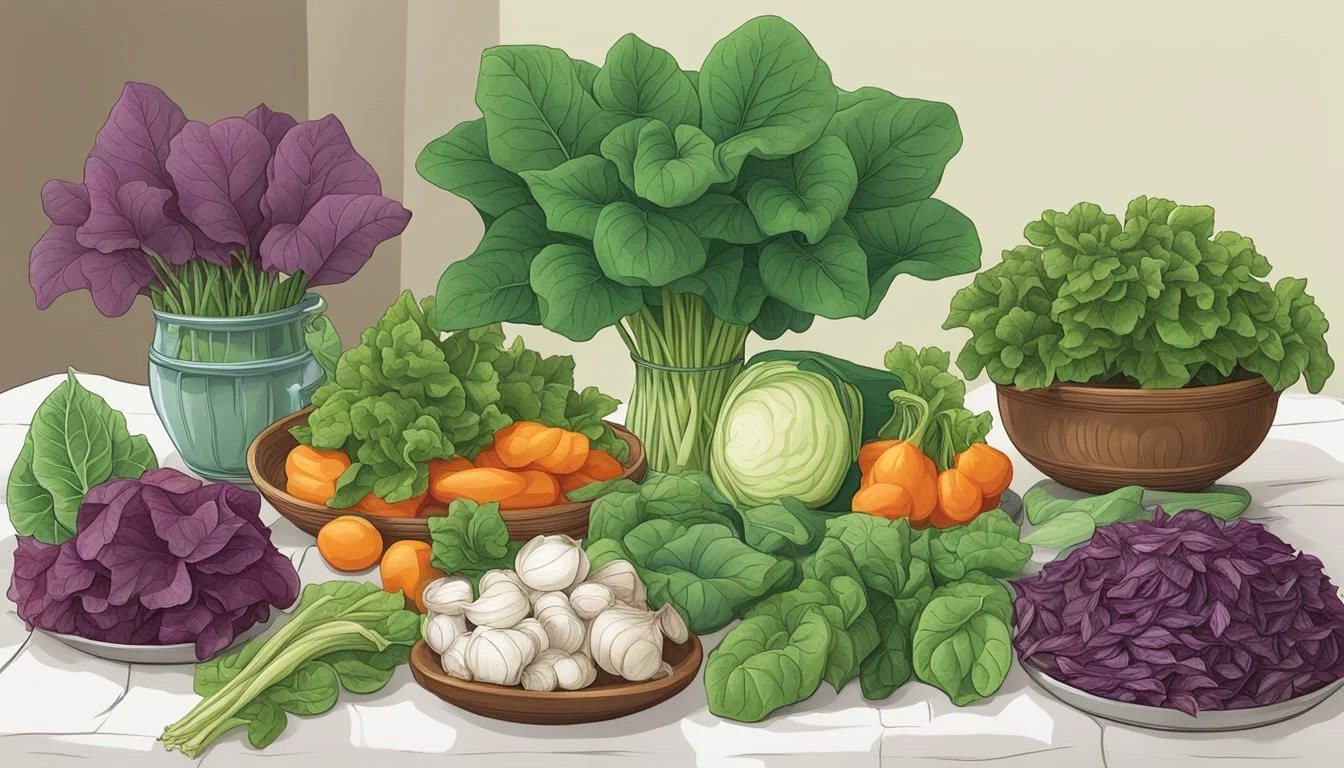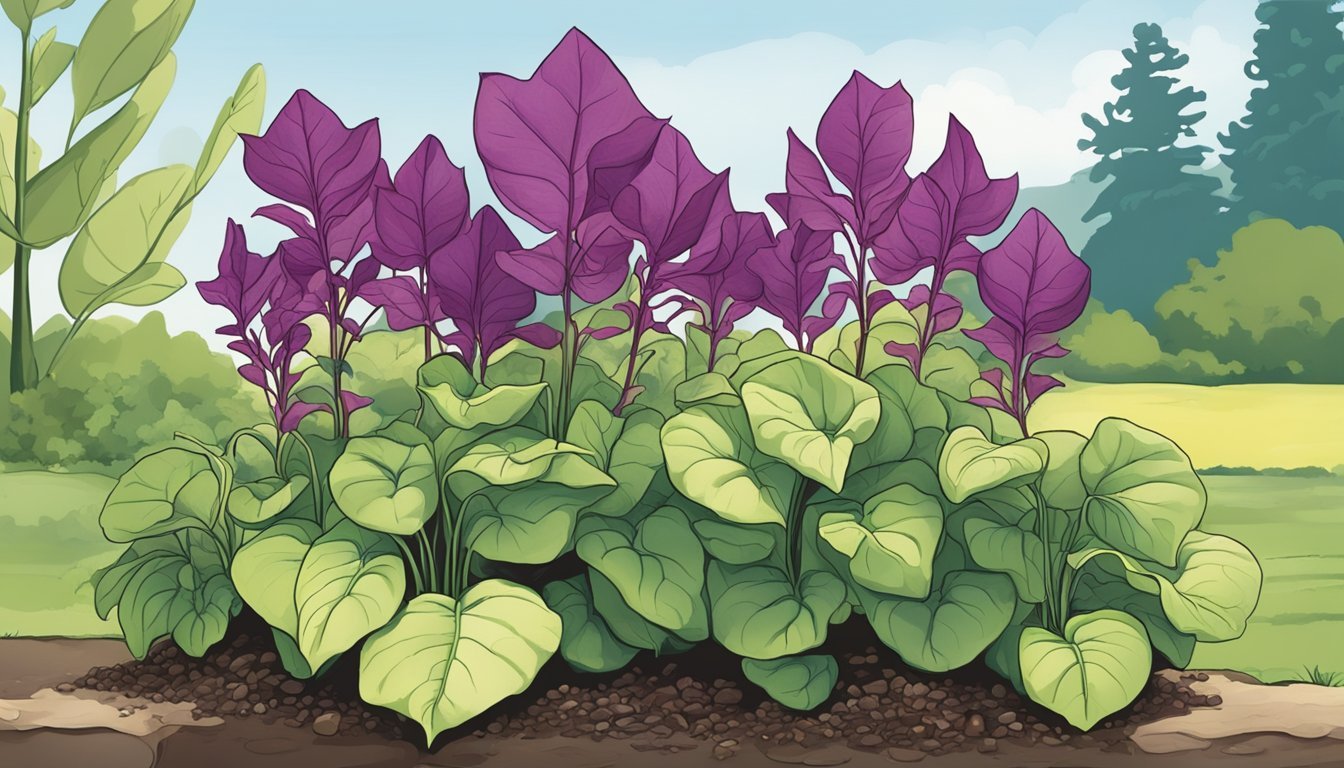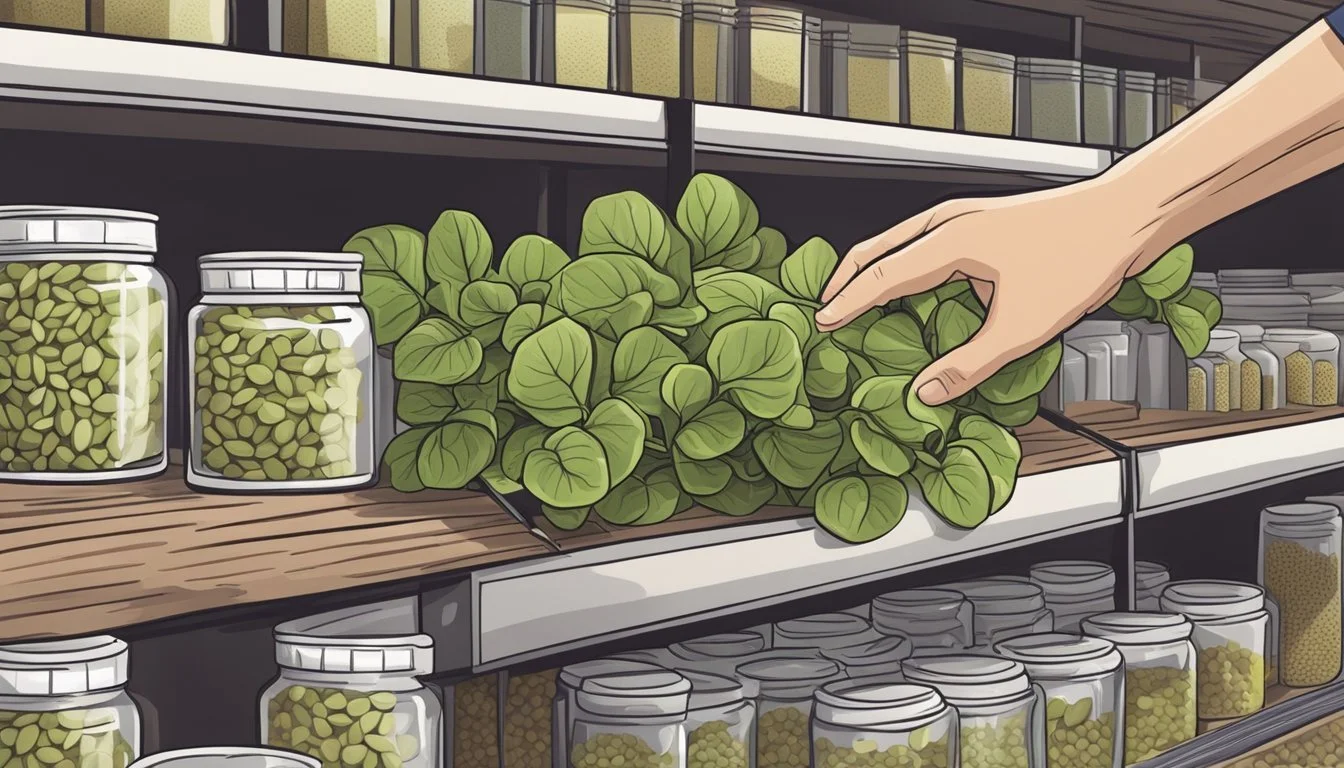Orach Substitutes
Best Alternatives for Your Recipes
Looking for a substitute for orach, also known as Atriplex hortensis, in your favorite recipes? Orach, a versatile vegetable often used in place of spinach or Swiss chard, can be substituted with several other greens depending on your needs and availability. Whether you're preparing a hearty risotto or a fresh salad, the right alternative can keep your dishes vibrant and flavorful.
Spinach and Swiss chard are the go-to substitutes for orach due to their similar texture and flavor profiles. In cooking, the red orach’s unique ability to stain water can easily be matched by the deep greens of these alternatives. For a more unique twist, consider using beet greens which offer a slightly earthy taste that complements a wide range of dishes.
Keep your kitchen versatile with these alternatives, ensuring your recipes remain delicious and nutritious. Whether during the growing season when orach might bolt or simply when it’s unavailable, these substitutes will never let your culinary creativity down.
Understanding Orach
Orach, also known as Mountain Spinach, is an annual herb native to Europe and Siberia, belonging to the Chenopodiaceae family. This versatile plant has both culinary and nutritional value, making it a notable substitute for spinach and other leafy greens.
History and Origin
Orach (Atriplex hortensis) has been cultivated since ancient times, with origins tracing back to Europe and parts of Asia, including Siberia. It was commonly used in Medieval European cuisine before spinach became more popular.
Known for its robust growth and hardiness, orach was often found in monastic gardens and was valued for its nutritional benefits during times when other greens were scarce. It has experienced renewed interest in modern times due to its adaptability and unique culinary properties.
Plant Description
Orach is an annual herb that can grow up to 6 feet tall. The leaves are broad and come in various colors, including green, red, and purple, adding aesthetic appeal to gardens. Its growth habit is similar to spinach, making it a suitable addition to diverse climates and soils.
Ideal Growing Conditions:
Soil: Well-drained, compost-rich
Sun: Full sun to part shade
Spacing: 12 to 18 inches apart
The plant is appreciated for its resilience, tolerating a bit of drought. Leaves can be harvested when the plant reaches about 6 inches in height, making it a practical choice for both small-scale and larger gardens.
Ideal Growth Conditions
Orach thrives when specific growth conditions are met, including quality soil, ample sunlight, and proper watering and fertilization practices. Addressing these needs can ensure robust growth and a bountiful harvest.
Soil Requirements
Orach prefers well-drained, compost-rich soil. Adding compost enhances soil fertility and helps retain moisture. The optimal soil pH for orach is between 6.0 and 7.5.
For container planting, use potting soil that provides excellent drainage. Regular garden soil can be improved by integrating compost or organic matter. Ensuring the soil is not too clay-like or sandy is key. If starting seeds indoors, use a seed starting mix to encourage healthy germination.
Sunlight Exposure
Orach requires full sun to partial shade to grow optimally. Positioning plants in an area where they receive at least 6 to 8 hours of direct sunlight daily will yield the best results.
When growing orach in containers, placing the pots in a sunny location is essential. If full sun is not available, choose a location that gets the most light possible during the day. Sun exposure directly impacts leaf production and color intensity, especially for varieties with red or purple leaves.
Watering and Fertilization
Orach plants should be kept consistently moist but not waterlogged. Water the plants deeply and regularly, approximately 1 inch per week. During dry periods, orach's drought tolerance helps it survive, but for best growth, avoid letting the soil dry out completely.
Using a balanced fertilizer can provide additional nutrients. Apply fertilizer once a month during the growing season. Incorporating compost at planting provides a steady nutrient supply. Avoid over-fertilizing, as this can lead to excessive leaf growth at the expense of flavor.
Maintaining these ideal growth conditions will help orach flourish, resulting in vibrant, healthy plants.
Cultivation Guidelines
Orach is a resilient plant that can grow in various conditions, making it a versatile addition to any garden. Key guidelines include proper sowing techniques, ensuring optimal germination, and maintaining healthy plant care practices.
Sowing Orach Seeds
Orach seeds should be sown in early spring, a couple of weeks post the last frost, or even in fall. Seeds must be planted at a depth of ¼ to ½ inch. Space them about 2 inches apart in rows that are 1 to 1.5 feet apart to allow enough room for growth.
For container gardening, use well-draining potting soil and place the containers in full sun. In 1-gallon pots, sow seeds 1 inch apart and thin them after germination to leave the healthiest seedlings, spaced around 6 inches apart.
Germination Process
Germination occurs best at soil temperatures between 50 to 75°F. Orach is frost-tolerant and can survive early spring and late fall frosts. Keep the soil consistently moist but not waterlogged to ensure successful seed germination.
Thinning is essential. Once the seedlings are a few inches tall, thin them to 8 to 10 inches apart. This spacing helps prevent overcrowding and ensures each plant has adequate nutrients and sunlight, promoting stronger growth.
Plant Care and Maintenance
Orach requires minimal maintenance. Water the plants regularly, especially during dry periods, to keep the soil moist. Adding mulch around the plants can help retain soil moisture and control weeds. Ensure the soil is well-drained and rich in compost.
Pests are usually not a significant issue, but keep an eye out for common garden pests and address them promptly. Regularly check the plants for signs of disease or insect damage, removing affected leaves if necessary.
Orach can tolerate drought to some extent but thrives best in moist conditions. Stagger planting every few weeks during the growing season to ensure a continuous harvest.
Harvesting Techniques
Orach can be harvested judiciously to ensure continuous growth and optimal use. Knowing the best timing and method is crucial for a bountiful and sustained yield.
Best Time to Harvest
Orach should ideally be harvested once it reaches about 6 inches in height. This early harvesting ensures tender, flavorful leaves which are perfect for salads or cooking.
If left to grow taller, the leaves may become tougher and less desirable.
Regular harvesting prevents the plant from bolting, which is when it starts to produce seed stalks and flower buds, negatively affecting leaf quality.
Methods of Harvesting
When harvesting, use a sharp pair of scissors or garden shears to cut the leaves. Harvest the outer leaves first and leave the inner leaves to continue growing.
Another method is to pinch off the leaves with your fingers carefully.
For sustainability, move from plant to plant, avoiding taking too many leaves from any single plant, ensuring continuous growth and productivity.
Storing Orach
After harvesting, store orach properly to maintain its freshness. Freshly harvested leaves can be kept in the refrigerator for up to a week.
For longer storage, orach can be dried. Wash and dry the leaves, then lay them out on a dehydrator tray or baking sheet lined with parchment paper.
Set the dehydrator or oven to 100-110°F (38-43°C) and dry until the leaves are crisp and brittle. This method preserves the orach for several months, maintaining its flavor and nutritional value.
Orach in the Kitchen
Orach is a versatile green that can be enjoyed both raw and cooked. It boasts a rich nutritional profile, making it a healthy addition to various dishes.
Nutritional Profile
Orach is packed with essential nutrients. It's an excellent source of vitamins A and C, which are crucial for immune function and skin health. Additionally, orach provides iron, calcium, and magnesium, key minerals that support bone health, muscle function, and overall vitality.
The green also contains antioxidants, which help combat oxidative stress and may contribute to reduced inflammation. Eating orach can thus provide numerous health benefits, commonly associated with a diet rich in leafy greens.
Raw and Cooked Uses
Orach can be utilized in numerous culinary applications, enhancing many dishes with its mild, spinach-like flavor. Raw orach leaves can be torn into salads, offering a vibrant color and a slight, pleasant bitterness. They pair well with sweet and mild ingredients to balance the flavor profile.
When cooked, orach serves as a substitute for spinach or Swiss chard in various recipes. It works well in soups, stews, quiches, and pasta dishes. Cooked orach leaves turn a uniform green but may tint the cooking water red. This versatile green can also be incorporated into risottos or simply sautéed with garlic and olive oil for a tasty side dish.
Comparable Produce
Orach is valued for its versatility and health benefits. It shares characteristics with several greens, making it a useful addition to various diets.
Common Substitutes
Spinach is often used in place of orach due to its similar texture and taste. Both can be used in salads, smoothies, and cooked dishes. Malabar spinach and New Zealand spinach, though not true spinaches, offer similar flavors and are excellent substitutes.
Swiss chard provides a comparable nutritional profile. It can replace orach in recipes requiring leafy greens. Its mild taste works in soups, stews, and sautés.
Lettuce, especially heartier varieties like romaine, can stand in for orach in raw applications. It lacks some of the nutrients but has a crisp texture.
Unique Qualities of Orach
Orach has a distinct capacity to grow in alkaline and saline soils, often thriving where other greens can't. This makes it valuable for cultivation in challenging environments. It is known for its high levels of magnesium and zinc, supporting the immune system and overall health.
The calcium content of orach is impressive, with just 100 grams providing substantial daily calcium needs. These unique qualities help differentiate orach from more common greens like spinach and chard. The vibrant color variations of orach, including green, red, and yellow, also add visual appeal to dishes.
Ornamental and Alternative Uses
Orach is not only valued for its culinary uses but also for its appeal in landscape design and various non-culinary applications. Its vibrant colors and resilient nature make it a versatile plant.
Landscape Design
Orach can be integrated into garden landscapes as an ornamental plant with its vibrant red and green hues adding visual interest. The plant can grow up to 4 to 6 feet tall, making it suitable for creating colorful borders or adding height contrasts within garden beds.
Red orach varieties, in particular, serve as eye-catching focal points, while the green varieties blend seamlessly with other leafy greens. In addition to traditional garden settings, orach can also be grown in containers with sufficient drainage, providing a portable and flexible landscaping solution.
Non-Culinary Applications
Beyond its decorative use, orach has practical non-culinary applications. It is often grown for its microgreens, which are rich in nutrients and favored in health-oriented products. The seedlings can be harvested early and used in salads or as garnishes.
In traditional contexts, orach has been used for medicinal purposes due to its nutritional profile. It’s also known for its soil-enriching properties when used in crop rotations, enhancing garden health naturally. Additionally, the vibrant leaves can be dried and used in crafting, adding a unique touch to floral arrangements and other decorative items.
These diverse uses highlight Orach’s adaptability both in garden aesthetics and functional applications.
Pests and Issues
Orach, despite its hardiness, can face several challenges. Aphids are common pests, feeding on the plant’s sap and causing stunted growth and distorted leaves. Insecticidal soaps or introducing natural predators can help manage aphid populations effectively.
Bolting is another issue where orach prematurely produces flowers and seeds. This often occurs due to prolonged drought or temperature fluctuations. Regular watering and maintaining consistent soil moisture can reduce the risk of bolting.
While orach can tolerate some drought, extended periods without water can weaken the plants and make them more susceptible to pests. Ensuring well-drained, compost-rich soil helps retain moisture and support healthy growth.
Frost sensitivity is another concern, as orach plants can suffer damage from late frosts. It is crucial to sow seeds only a couple of weeks after the last frost date. Using row covers can provide extra protection against unexpected cold snaps.
In summary, managing pests like aphids, preventing bolting through consistent watering, and protecting orach from frost are key factors in maintaining healthy plants. Regular monitoring and appropriate interventions can help ensure successful cultivation.
Buying and Storing Seeds
When buying and storing orach seeds, it is essential to focus on selecting high-quality seeds and adhering to optimal storage practices to ensure viability for planting.
Selecting Quality Seeds
Look for orach seeds from reputable suppliers known for organic and non-GMO varieties. Examine the seeds to ensure they are intact, clean, and free from discoloration or mold. Purchasing seeds labeled with a high germination rate percentage increases the likelihood of successful planting.
Buying seeds with details on the packaging including the harvest date and current year enhances reliability. Opt for heirloom varieties if available, as they tend to be more robust and flavorful when grown.
Seed Storage Best Practices
Store orach seeds in a cool, dry place to maintain their viability until planting. Use airtight containers such as glass jars or sealed plastic bags, and consider adding a silica gel packet to absorb moisture.
Label each container with the seed type and date of storage to keep track. Refrigeration can further extend seed shelf life, but avoid freezing seeds, which may damage their viability. Proper storage ensures seeds remain ready for planting, whether for salads or other dishes.











